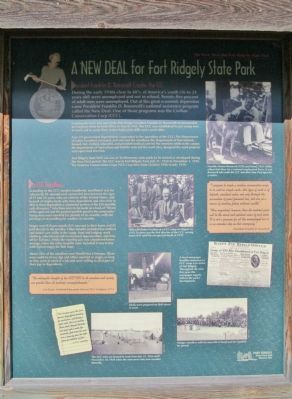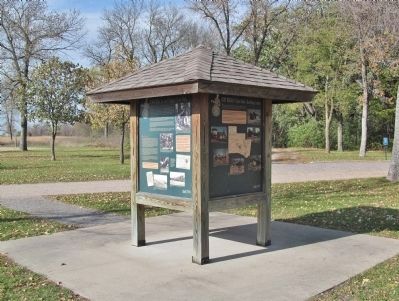Near Fairfax in Nicollet County, Minnesota — The American Midwest (Upper Plains)
A New Deal for Fort Ridgely State Park
The New Deal and Fort Ridgely State Park
— United States Civilian Conservation Corps —
President Franklin D. Roosevelt Creates the CCC
During the early 1930s close to 40% of America's youth (16 to 24 years old) were unemployed and not in school. Twenty-five percent of adult men were unemployed. Out of this great economic depression came President Franklin D. Roosevelt's national assistance program called the New Deal. One of those programs was the Civilian Conservation Corp (CCC).
Creating the CCC was one of the first things President Franklin D. Roosevelt recommended to Congress when he took office in March 1933. The CCC was established to put young men to work and to assist them in developing job skills and work ethic.
Four US government departments cooperated in the operation of the CCC: The Department of Labor recruited, screened, and selected the enrollees; the Department of War trained, housed, fed, clothed, educated, and provided medical care for the enrollees while in the camps; the department of Agriculture and Interior selected the work sites, designed the work projects and supervised the men.
Fort Ridgely State Park was one of 30 Minnesota state parks to be started or developed during the New Deal period. The CCC was in Fort Ridgely from July 31, 1934 to November 1, 1935. The Veterans Conservation Corps (VCC) was here from October 1936 to July 1939.
The CCC Enrollees
According to the CCC enrollee handbook, enrollment was for "physically fit, unemployed, unmarried men between the ages of 17 and 23 years, who are citizens of the United States, and in need of employment, who have dependents and who wish to allot to these dependents a substantial portion of the $30 monthly cash allowance." Selections were to be made on a basis of "fitness of the applicant and the greatest possible good to the community." Young men were enrolled for periods of six months, with the privilege of re-enrolling for another six months.
Wages were $30 per month; $25 was sent to their home and $5 paid directly to the enrollee. Other benefits included free medical and dental care while in the camp, food and lodging, work clothing, educational and recreational opportunities, and time off for holidays. While the monthly pay was considered below average, when the other benefits were included it was in line with typical wages for that time.
About 10% of the enrollees were World War I Veterans. These men could be of any age and either married or single, so long as they were in need of a job and were willing to allot part of their pay to dependents.
"The intangible benefits of the CCC/VCC
to its members and society are greater than its material accomplishments."
Lee Evans, Assistant Education Advisor, VCC Company 2713
"Our location upon the level top of a bluff offered absolutely no protection, and during a high wind, dirt was readily blown about, through the tents, into food and it made life miserable. Just across the road was a large pig pen, the birth place for millions of flies."
A CCC enrollee
"I propose to create a civilian conservation corps to be used in simple work...this type of work is of definite, practical value, not only through the prevention of great financial loss, but also as a means of creating future national wealth."
"More important, however, than the material gains will be the moral and spiritual value of such work. It is not a panacea for all the unemployed but it is an essential step in this emergency."
President Franklin D. Roosevelt
Topics and series. This historical marker is listed in these topic lists: Charity & Public Work • Parks & Recreational Areas . In addition, it is included in the Civilian Conservation Corps (CCC), and the Former U.S. Presidents: #32 Franklin D. Roosevelt series lists. A significant historical month for this entry is March 1933.
Location. 44° 27.165′ N, 94° 43.889′ W. Marker is near Fairfax, Minnesota, in Nicollet County. Marker can be reached from County Highway 30, 0.7 miles west of State Highway 4, on the right when traveling west. Marker is northwest of the cemetery in Fort Ridgely State Park; fee area – a Minnesota state park vehicle permit is required. Touch for map. Marker is in this post office area: Fairfax MN 55332, United States of America. Touch for directions.
Other nearby markers. At least 8 other markers are within walking distance of this marker. CCC Camp Life is a Healthful One (here, next to this marker); Fort Ridgely State Park's Buildings Today (here, next to this marker); Working Year-Round to Develop the Park (here, next to this marker); Chief Mou-Zoo-Mau-Nee State Monument (about 400 feet away, measured in a direct line); Captain John S. Marsh State Monument (about 400 feet away); Eliza Müller State Monument (about 400 feet away); To the Memory of Hazen Mooers (about 400 feet away); Joseph LaFramboise - (about 500 feet away). Touch for a list and map of all markers in Fairfax.
More about this marker. photo captions:
• Franklin Delano Roosevelt (FDR) and friend, 1933. While others had ideas for a national employment force, it was Roosevelt who made the CCC and other New Deal agencies a reality.
• FDR with Robert Fechner at a CCC camp on August 12, 1933. Fechner was the first director of the CCC, serving from 1933 until his unexpected death in 1939.
• A local newspaper headline announces a CCC camp is to arrive at Fort Ridgely. Throughout the next five years the newspaper eagerly follows the park's development.
• Meals were prepared on field stoves in tents.
• Hungry enrollees with tin mess kits in hand wait for lunch to be served.
• The CCC men are housed in tents from July 31, 1934 until November 10, 1934 when the men move into new wooden barracks.
(photographs courtesy of the FDR Library or the Minnesota Department of Natural Resources)
Also see . . .
1. Civilian Conservation Corps. Wikipedia entry. (Submitted on February 21, 2014.)
2. The Civilian Conservation Corps. American Experience. (Submitted on February 21, 2014.)
3. Civilian Conservation Corps. United States History. Online Highways. (Submitted on February 21, 2014.)
Credits. This page was last revised on December 15, 2020. It was originally submitted on February 21, 2014, by Keith L of Wisconsin Rapids, Wisconsin. This page has been viewed 527 times since then and 16 times this year. Photos: 1, 2. submitted on February 21, 2014, by Keith L of Wisconsin Rapids, Wisconsin.

